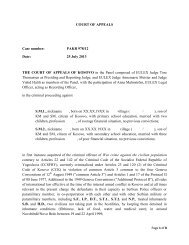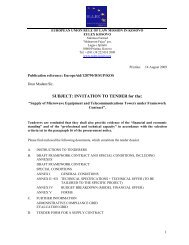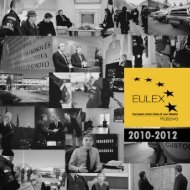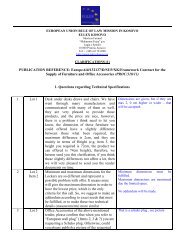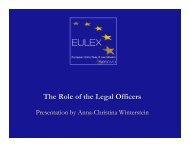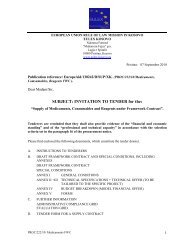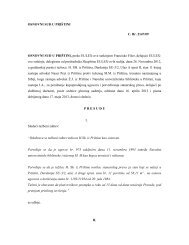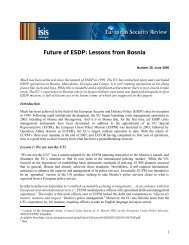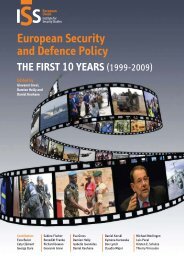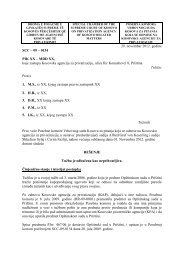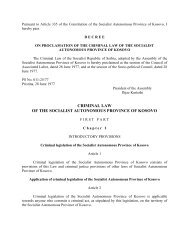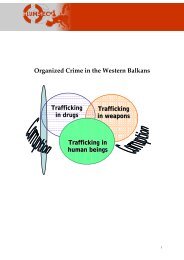DEPARTMENT OF FORENSIC MEDICINE EULEX-KOSOVO EULEX ...
DEPARTMENT OF FORENSIC MEDICINE EULEX-KOSOVO EULEX ...
DEPARTMENT OF FORENSIC MEDICINE EULEX-KOSOVO EULEX ...
You also want an ePaper? Increase the reach of your titles
YUMPU automatically turns print PDFs into web optimized ePapers that Google loves.
5.2 ICTY “SPARE SAMPLES”<br />
In 2000, ICTY collected bone samples for future DNA analysis. At the close of ICTY operation, these<br />
samples were handed-over to UNMIK. When OMPF was created in 2002, the samples cut from NN bodies<br />
were sent to ICMP for DNA analysis. The samples belonging to bodies already identified and returned to the<br />
families in 2000 (referred here below as “spare samples”) were kept at the mortuary.<br />
In 2006, DFM sent a spare sample for DNA analysis on the request of the family who wanted to confirm the<br />
identity of a body buried in 2000. The identity was confirmed. Two more spare samples were sent in 2008,<br />
again on the request of the families. The identities were again confirmed.<br />
In 2009, DFM started to send spare samples without request from family members. DFM focused on two<br />
sites in Skenderaj/Srbica municipality, namely Makermal/Makrmalj and Rezalla/Rezala, where DFM<br />
suspected that some mis-identifications might have occurred. Out of 48 spare bone samples sent for DNA<br />
analysis, 29 were associated with presumptive identities, the families having agreed to give blood. Out of<br />
these 29 samples, 18 results confirmed the initial identification made in 2000, four results were negative and<br />
7 are still pending. The 19 samples sent without presumptive identity have not been matched with any blood<br />
references to date.<br />
One negative result was received for Makermal/Makrmalj. The mis-identified body was exhumed and the<br />
correct one was returned to the family (see para. 5 below).<br />
DFM is continuing the analysis of Rezalla/Rezala site and additional families will be contacted for blood<br />
collection with the hope that the three mis-identifications will be corrected.<br />
Other sites will then be considered for review and analysis and more spare samples might be sent for DNA<br />
testing.<br />
5.3 ANALYSIS BY EVENT – 1: PASTASEL/PUSTO SELO (MUNICIPALITY <strong>OF</strong> RAHOVEC/ORAHOVAC)<br />
Pastasel/Pusto Selo was the first event mentioned in the SWG (in 2006) as a potential test for cases of misidentifications.<br />
106 bodies were buried by families in 1999. 96 of these bodies were then exhumed by Serbian forensic<br />
teams to be autopsied and reburied in various cemeteries in different municipalities. These cemeteries were<br />
then re-exhumed either directly by families looking for their missing relatives or by ICTY in 1999. Most of the<br />
recovered bodies were identified based on clothing, among them 56 belonged to victims of Pastasel/Pusto<br />
Selo event. Between 2000 and 2009, 37 additional bodies were identified with DNA as victims of this event.<br />
At the beginning of 2010, 13 men were still considered missing from Pastasel/Pusto Selo event and DFM<br />
had the bones of a minimal number of 28 unidentified males (bodies and body parts) recovered from<br />
cemeteries where other Pastasel/Pusto Selo victims had been found (Prizren – Tusus Cemetery,<br />
Shiroko/Siroko Cemetery, Serbice e Poshtme/Donja Srbice, etc). The blood profile of the relatives of the 13<br />
missing men did not match the bone profiles of any of the remains at the morgue. The remains of these men<br />
have most likely been buried under the wrong identity by other families<br />
Nevertheless, most of the families were opposed to the re-exhumation of their relatives for new autopsy and<br />
DNA testing. As a matter of fact, no family from Pastasel/Pusto Selo ever approached DFM with a request<br />
for re-exhumation. The best alternative was to collect blood samples from as much families as possible in<br />
order to compare these blood profiles with the profiles of the NN bodies under DFM custody. Obviously, this<br />
would not clear all cases of mis-identifications, but only those where the correct remains lie at the morgue.<br />
<strong>EULEX</strong>/DFM 2010 Annual Activities Report (Missing Persons Operation)<br />
10



